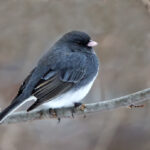Cape May Naturally is the NJ Audubon’s column about birding and nature. It is written for the Herald and Do the Shore by a rotating cast of experts.
Technology and nature are certainly not two areas that we often place side by side, but as with all other sectors in society, advancements in communication, connectivity, and, yes, artificial intelligence, have combined to enhance our experience in the outdoors – if we so choose. Whether you’re trying to identify the noisy bird that wakes you up each morning or want to learn more about the butterflies in your garden, or even feel inspired to contribute data to community science projects, odds are good that there’s an app for that.
What’s an E-Bird?
When it comes to birds, two tools from Cornell University’s Lab of Ornithology often leap to mind. The first is eBird, a community science application that allows observers to record the birds they find anywhere in the world. Over the last two decades, eBird has grown into one of the world’s largest biodiversity-focused projects, with over 100 million bird sightings contributed by hundreds of thousands of users each year. In Cape May County, over 15,000 eBirders have submitted 380,000 observations, in the form of bird lists from single locations, since the project commenced.
eBird can serve various purposes, ranging from the personal, by acting as a record of every bird one has ever seen, along with photos, videos and audio recordings of those birds, to the professional, allowing organizations and government agencies to access this database to protect birds and the places they call home.
Merlin, the Bird Wizard

The other Cornell product is called Merlin, a novel application that utilizes the data, photos, and audio from eBird to drive a robust bird identification tool. There are three main ways to use Merlin. The first is the Bird ID Wizard, which walks observers through a series of questions regarding date, location, the bird’s features. The second is photo identification, which can work with photos of an unknown bird taken on a cell phone or uploaded from elsewhere. But its most popular feature is sound ID, which allows users to simply press play and wait for Merlin to detect and then identify birds as they’re picked up on a cell phone’s microphone. It’s not perfect, but it’s pretty darn good, and getting better all the time. Most importantly, it’s making birds and birding more accessible than ever before.
Of course, there’s more than just birds. Enter iNaturalist, an “online social network of people sharing biodiversity to help each other learn about nature,” per its website. iNaturalist combines the community science aspect of eBird with the identification features of Merlin, allowing users to upload not just birds but also insects, plants, and most any form of life that can be encountered. An added feature is its community-based review process, allowing users to offer their own expertise to assist with the quality of data in the app. The combination of learning and contributing simultaneously is what makes iNaturalist special, and it’s a resource that I reach for on a near-daily basis.

But that’s not all! Right here in Cape May County, a group of scientists and engineers have combined to create a new product called Terra. These devices, which are available at the Cape May Bird Observatory’s Northwood Center and online, record and identify the birds in your own backyard, and come with built-in sensors that detect radio or satellite tags on migrating animals that could be as large as an eagle or as small as a Monarch butterfly. In time, it is hoped that a vast network of Terra devices around the world can aid in teaching us more about migratory connectivity and lend us helpful information that will assist in protecting populations of migratory animals. And yes, of course, there’s also an app for that, where identifications are logged in real time and where users can also listen to curated locations around the world. Learn more at terralistens.com.
If you want to learn even more about these apps, have interest in a Terra unit, or just generally want to enhance your outdoors experience, then stop in and see us at the Cape May Bird Observatory: 701 East Lake Drive, Cape May Point. We’re here from 9:30am to 4:30pm daily.








